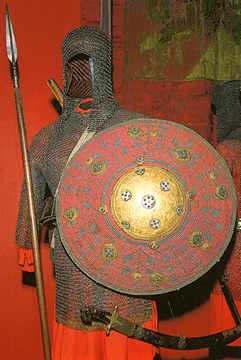Petyhorcy

Petyhorcy (singular: Petyhorzec, by.Пяцігорцы) was a type of 16-18th century medium-armoured cavalry in Great Duchy of Lithuania and Polish-Lithuanian Commonwealth. Initially it was formed from Circassians which came to Lithuania from under the rule of the Russian Tsardom (and hence were sometimes referred to simply as Czerkiesi - Circassians). The name is a corrupted Russian-language reference to a region of "Pyatigorye" ("Five Mountains", Beshtau) in Caucasus, which corresponds to the city of Pyatigorsk.[1]
Initially formed by Caucasian mountaineers, the light cavalry units were with time also joined by Lithuanian Tartars and local landed gentry. Much like other steppe units, the petyhorcy units were initially armoured only in light misiurka (chainmail cap) and karwasz, a type of steel arm protectors. The offensive armament included a lance, possibly identical to the long lance used by Polish Winged Hussars. The first such units were formed during the reign of king Stefan Batory. A commander of one of such units, cerain Temruk Szymkowic, was recorded as a rotmistrz already during the reign of Sigismund August, but it is uncertain whether he commanded a circassian unit at that time.
With time the unit type evolved into medium cavalry, almost identical to Polish pancerni. The armour used by those later units included a full chainmail armour with misiurka and arm protectors and often also a kalkan, a round Turkish-style shield. In 17th century the chainmail was gradually replaced by cuirasses. The offensive armament in use by Petyhorcy included a 3 to 4-metres-long lance of bear spear (rohatyna), as well as a Polish sabre, two pistols and a musket carbine or an eastern-type bow.
Following the military reforms of 1776 the Petyhorcy banners were reformed into Petyhorcy Brigade of National Cavalry (Petyhorska Brygada Kawalerii Narodowej), otherwise known as the 2nd National Cavalry Brigade of the Grand Duchy. It ceased to exist following the fall of the Kościuszko Uprising.